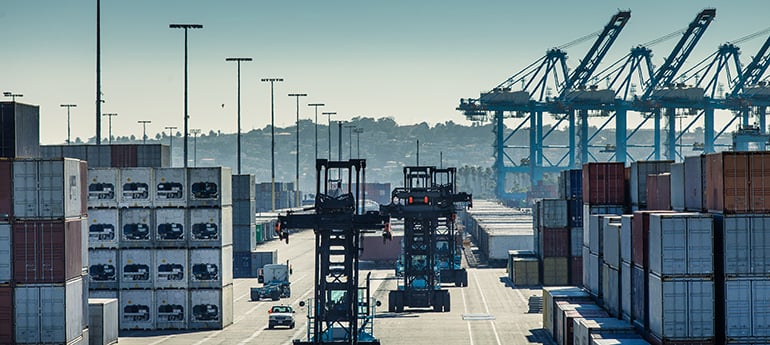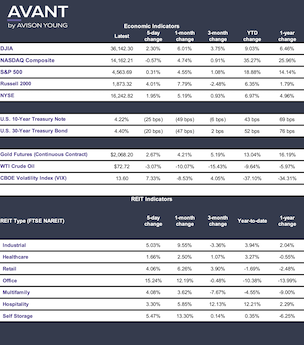Port activity adjusts to consumer spending shifts

U.S. port activity is an important barometer for the industrial sector given its ties to space utilization and investment activity. It also provides a glimpse into how retailers plan their inventory ahead of the pivotal holiday shopping season. As consumer demand slows heading toward 2024, here is a look at how the ports are faring and what that means for the retail and industrial sectors.
Principal
Head of Industrial Capital Markets
[email protected]
+1 312.273.9486
After a slow start to 2023, U.S. port activity accelerated in the second half of the year and is hovering around pre-pandemic levels. Many ports are recording cargo volumes that are notably lower than the robust numbers seen in 2021 and 2022, but reflect historically strong levels. Heading into 2024, these are key indicators to watch given their ties to industrial space utilization and investor appetite for assets in port-centric markets.
In October, the Port of Los Angeles recorded a volume of 725,775 TEUs, the standard cargo volume measurement. This represents the third consecutive monthly increase. The total for the first 10 months of 2023, however, decreased by 16.6% year-over-year, reaching 7.12 million TEUs.
Cargo also increased at the Port of Long Beach in October, rising a second consecutive month (to 755,150 TEUs) amid preparations for the holiday season. This was a 14.7% increase from October of 2022, with imports increasing 23.6% and exports decreasing 24.8%. While volume for the first 10 months of 2023 was down by nearly 18% year-over-year, port authorities are predicting moderate growth for the remainder of the year as retailers continue to stock shelves for the winter.
The Port of Savannah, which has seen significant expansion in recent years, recorded 449,000 TEUs in October, the highest monthly volume for 2023 and the port’s fourth-busiest October in history. The volume is nearly 20% lower year-over-year from 2022 when port volumes were near record highs.
The moderating activity reflects the recalibration taking place in the economy, as consumer demand slows due to the impact of higher interest rates and other economic headwinds. Retailers were more constrained in ordering goods for the 2023 holiday shopping season as they factored in a cooling in consumer demand. And, some were also working through surplus inventory from previous buying cycles. According to the U.S. Commerce Department, consumer spending tapered back in October, increasing by just 0.2% following a 0.7% increase in September.
The slower port cargo volumes are also reflected in leasing fundamentals in port-oriented markets. Many are recording lower volumes due to shifting economic conditions and a pull back by some large occupiers as they hold off on expansions or place space back on the market for sublease.
One example is Houston, the nation’s largest port for waterborne tonnage and a key economic vehicle for the region. Avison Young research notes that while Q3 2023 net absorption in Houston was 3.4 million-square-feet (msf) higher than in Q3 2022, it dipped 9% year-to-date and has been trending downward after its peak in 2020. This indicates a moderation in the pace of demand following exceptionally high levels during 2021 and 2022.
Total cargo volume at Port Houston reached 366,208 TEUs in October 2023, up from 319,990 in January 2023 and also higher than the pre-pandemic figure of 268,773 TEUs in January 2020.

All eyes on consumer spending for the holidays
With consumer spending levels trending downward ahead of the holidays, retailers have taken a more cautious approach to buying inventory for this pivotal retail season. Many focused on discounting merchandise and adjusting their port distribution channels to lower distribution costs. Some have changed their port strategies to include spreading goods across multiple ports. Others are focused on lowering travel costs by shifting cargo deliveries to ports those that are closer to their fulfillment centers.
A recent CNBC Supply Chain Survey noted the majority of respondents were not expecting a surge in demand during the peak holiday shopping season. Respondents said that the majority of products moving into stores this holiday season are promotional, lower-cost items. Given higher interest rates and their impact on the housing market, this pullback is particularly impacting the flow of appliances, furniture, household goods and general luxury items.
A review of the recent Black Friday to Cyber Monday shopping period shows strong sales in an environment of deep discounts, raising cautionary tones about how retailers will finish the season. According to CNBC and Adobe Analytics, online shopping increased by nearly 8% year-over-year to $38 billion during that five day period starting on Thanksgiving. A record 200 million shoppers hit the stores and online sites during that period, but many were focused on bargains.
The National Retail Federation (NRF) tempered its expectations this year, predicting a 3% to 4% year-over-year growth in holiday spending from Nov. 1 to Dec. 31. This figure aligns with the average annual growth rate before the pandemic, but is much smaller than the 9.1% increase in 2020, the 12.7% increase in 2021 and even the more modest 5.4% increase for 2022. The NRF is predicting a slower pace of spending this year as consumers look for deals and discounts to stretch their budget dollars.
The global port system is a critical component of the logistics and distribution network that drives the industrial sector. By monitoring the flow of goods into and out of U.S. ports, the industry can gain important insights into supply-demand trends that will impact space usage and overall investment activity.

